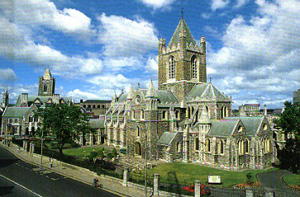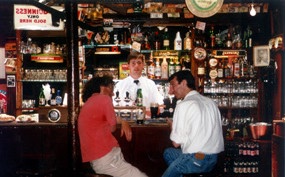 Ireland Ireland
Introduction
Land and Resources
Economy
Population
Goverment
History
Things to see
Ireland in Europe
 Dublin Dublin
Short
History
Important People
A guided tour
 Lifestyle Lifestyle
Art
Music
Sports Heroes
Nightlife
Fashion
 Education Education
General
Information
To school in Ireland
 Crumlin College Crumlin College
Introduction
Departments
Meet
the students
Meet
the teachers
 Lingua E Lingua E
The J.E.P.
Diary
of a visit to
Belgium
|

Christ Church Cathedral
 Lord Edward St, Dublin 2
Founded in 1083 by the Danish Kind Sitric and Donatus, Bishop of Dublin. Demolished by the Normans in 1172 and rebuilt by them during the next fifty years. One of the main points of interest is the tomb of Stongbow, who conquered Dublin during the reign of Henry II. The monument depicts strongbow and his son, whom Strongbow is said to have killed for cowardice in battle. While King James II was in Dublin in 1689, the cathedral was seized, and for a brief period, the rites of the pre-Reformation faith were restored and Mass celebrated in the king's presence. Christ Church is the traditional venus for Dubliner welcoming in the New Year: songs, drink and tolerant policemen, but it' not quite Piccadilly Circus. Lord Edward St, Dublin 2
Founded in 1083 by the Danish Kind Sitric and Donatus, Bishop of Dublin. Demolished by the Normans in 1172 and rebuilt by them during the next fifty years. One of the main points of interest is the tomb of Stongbow, who conquered Dublin during the reign of Henry II. The monument depicts strongbow and his son, whom Strongbow is said to have killed for cowardice in battle. While King James II was in Dublin in 1689, the cathedral was seized, and for a brief period, the rites of the pre-Reformation faith were restored and Mass celebrated in the king's presence. Christ Church is the traditional venus for Dubliner welcoming in the New Year: songs, drink and tolerant policemen, but it' not quite Piccadilly Circus.
St Patrick's Cathedral
 Patrick St, Dublin 2.
Close to Christ Church, and also Church of Ireland, St, Patrick's was founded in 1191 by John Comyn, first Anglo-Norman Archbishop of Dublin. The architecture is described as `early English`, the square tower being added in the fourteenth century, and the two-hundred foot spire in the eighteenth century. It is mainly associated with Jonathan Swift of Gulliver's Travels fame, who was Dean of the cathedral from 1713 to 1745, and whose tomb is there, There are also monuments to John Philpot Curran the orator, Samuel Lover novelist and poet and Turlough O'Carolan the great Irish harpist. In the fourteenth century, the catherdal housed a university, later suppressed by Henry VIII. The cathedral was extensively restored in the mid-nintheenth century by a member of the Guinness family.
Patrick St, Dublin 2.
Close to Christ Church, and also Church of Ireland, St, Patrick's was founded in 1191 by John Comyn, first Anglo-Norman Archbishop of Dublin. The architecture is described as `early English`, the square tower being added in the fourteenth century, and the two-hundred foot spire in the eighteenth century. It is mainly associated with Jonathan Swift of Gulliver's Travels fame, who was Dean of the cathedral from 1713 to 1745, and whose tomb is there, There are also monuments to John Philpot Curran the orator, Samuel Lover novelist and poet and Turlough O'Carolan the great Irish harpist. In the fourteenth century, the catherdal housed a university, later suppressed by Henry VIII. The cathedral was extensively restored in the mid-nintheenth century by a member of the Guinness family.
National Museum
Kildare st. Dublin 3.
Divided into three sections- Irish Antiquities, Art and Industrial, and Natural History (which is entered from Merrion Square), the National Museum was opened in 1890, and much of the original collection was made up of bequests from the Royal Irish Academy, the Royal Dublin Society and Trinity College. The National Antiquities section comprises the finest collection of early European Christian art. Among the most impressive pieces are the Ardagh Chalice, the cross of Cong and the Tara Brooch. The Natural History section has a complete collection of the prehistoric giant Irish deer, known as Irish elk.
Dublin Writers Museum
18-19 Parnell Square,Dublin 1.
The Dublin Writers Museum is a celebration of literary Dublin. Featured are exhibits on the lives and works of Dublin's literary celebrities over the past three hundred years including Yeats, Shaw, Beckett, Swift and Joyce.Their books, letters, portraits and some personal items are presented in the exhibition.The museum is housed in a beautifully restored Georgian house and is a pleasure in itself. An essential site for anyone who wants to discover Dublin's immense literary heritage.
The Hugh Lane Municipal Gallery of Modern Art
Parnell Square, Dublin 1,
Named after the founder and benefactor, Sir Hugh Lane, who established the gallery in this fine Georgian mansion, Charlemont House, in 1907. Because suitable premise were not available to house Sir Hugh's own collection, he loaned his pictures to the National Gallery of London, and when he drowned on board the Lusitania in 1915, a codicil in his will bequeathing the paintings to the Municipal Gallery in Dublin was held invaild since it lacked the necessary two witnessing signatures. In 1959, a compromise was reached, and from that day the collection was divided into two groups to be displayed in both London and Dublin for alternating five year periods. Among the paintings in the gallery are works by Monet, Boudin, Renoir, Corot, Augustus John, and works representing many modern European and Irish artists.
National Gallery of Ireland
Merrion Square, Dublin 2.
Opened in 1864 and based originally on the collection of William Dargan and George Mulvany, the gallery has, through various bequests including those of George Bernard Shaw, Sir Hugh Lane, Edward Martyn and Lady Milltown, built up an extensive and representative collection from all the European schools.
PUBS:
The Old Brazen Head
 The Brazen Head in Bridge Street, if not the oldest establishment of it's kind in Europe, is certainly the oldest in the country. It was built on the site of a tavern dating back to the 12th century.
The first question asked by the stranger, on looking around the house is, "How old is this place?" and once was heard the reply, " Sure, they were serving drinks in here before a license was needed to do so".This was no idle boast, the first licensing law was not passed until 1635, but there is every possibility that the Brazen Head was in excistence some time prior to this.
Another question often asked is "How did this place get it's name?".One interesting but unreliable version goes that it was an imitation of a tavern in Limerick Called "At the sign of the Brazen Head", named after a red-headed girl who, while trying to get a better view of the siege of Limerick, lost her head to a Williamite army's cannon.But in fact the name Brazen Head was Common enough in the 1660's. The Brazen Head boasts a first class Restaurant with full Bar License serving lunch and evening Dinner. A superb Carvery Lunch and evening dinner is served daily in the Bar. Music is played in the Music Lounge nightly wher you can join in the fun.
The Brazen Head in Bridge Street, if not the oldest establishment of it's kind in Europe, is certainly the oldest in the country. It was built on the site of a tavern dating back to the 12th century.
The first question asked by the stranger, on looking around the house is, "How old is this place?" and once was heard the reply, " Sure, they were serving drinks in here before a license was needed to do so".This was no idle boast, the first licensing law was not passed until 1635, but there is every possibility that the Brazen Head was in excistence some time prior to this.
Another question often asked is "How did this place get it's name?".One interesting but unreliable version goes that it was an imitation of a tavern in Limerick Called "At the sign of the Brazen Head", named after a red-headed girl who, while trying to get a better view of the siege of Limerick, lost her head to a Williamite army's cannon.But in fact the name Brazen Head was Common enough in the 1660's. The Brazen Head boasts a first class Restaurant with full Bar License serving lunch and evening Dinner. A superb Carvery Lunch and evening dinner is served daily in the Bar. Music is played in the Music Lounge nightly wher you can join in the fun.
STORES AND SHOPS:
The main shopping areas are Nassau Street, Grafton Street, St. Stephen's Green, Temple Bar, O'Connell Street and Henry Street. The department stores are on Grafton Street (Brown Thomas, excellent for Irish fashion design has now relocated to the former Switzers building) and in O'Connell Street (Clery's, for the more budget-conscious). For Irish and European gifts try House of Ireland on Nassau Street.
Shopping malls include the St. Stephen's green shopping centre, the largest in the city, which is a bright and spacious shopping area where you can buy just about anything and also have a meal (it can be very crowded, especially in summer). The Powerscourt Townhouse on Clarendon Street (follow the sign on Grafton street) is on a smaller scale and specialises in wonderful restaurants, cafes, crafts, jewellery and clothes stores.
On the other side of Grafton street in Dawson street is the royal Hibernian way, a small shopping mall with some very exclusive clothes shops. Finally, there is the iIlac centre which is second only to St Stephen's green. Here you will find many clothes stores for all ages and a large branch of Dunnes Stores, an Irish clothes and food shop chain.
Branches of Marks and Spencers can be found in Grafton Street and Henry street, where most of the larger chain stores are represented, including the body shop for natural beauty products, HMV for music and concert tickets and the Levis store for casual clothing.
Of course, Dublin wouldn't be Dublin without its markets, and one of the best of Mother Redcap's in Back Lane (opposite Christ Church cathedral). This wonderful indoor market has stalls selling clothes and music, books and antiques, as well as excellent cakes and cheeses (try the Gallic Kitchen just inside the entrance). If you're looking for bargain second-hand clothes, try the Iveagh market, next door to Mother Redcap's
|
 Ireland
Ireland
